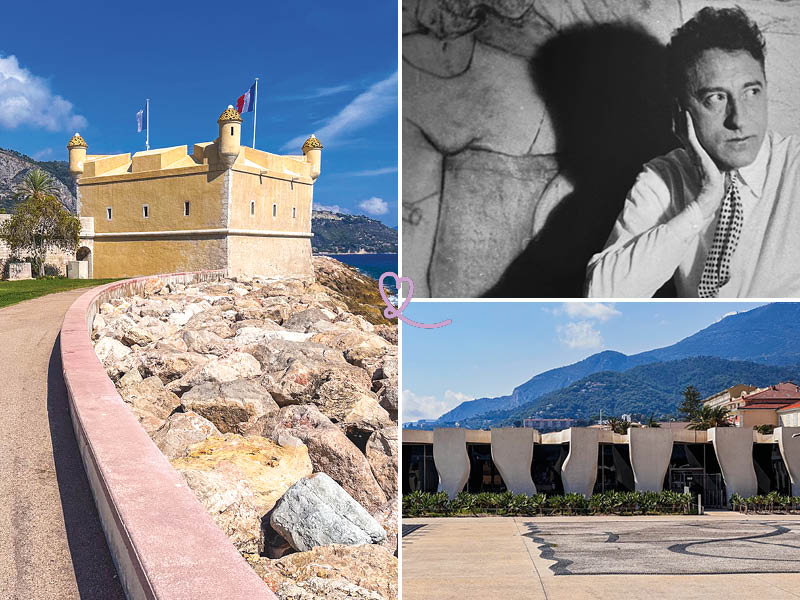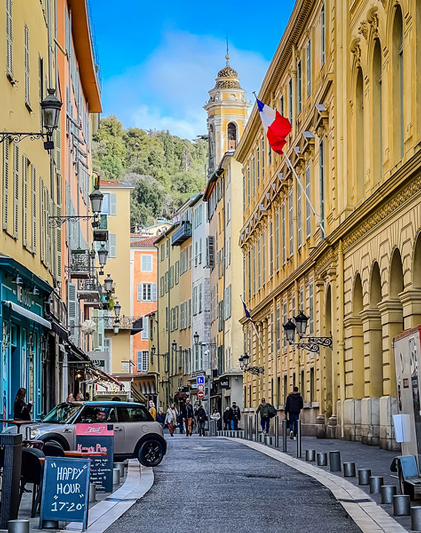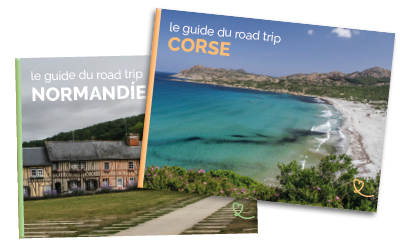On the seafront, at the tip of the old town, we recommend a visit to the Musée Jean Cocteau in Menton. Dedicated to the work of the famous 20th-century writer, poet and artist, it is organized in two parts: the Bastion and the Séverin Wunderman Collection.
We loved visiting the Bastion, with its temporary exhibitions on Jean Cocteau. Unfortunately, the second building, designed by renowned architect Rudy Ricciotti, was not open to the public.
In this article, you’ll find some useful tips to help you prepare for your visit and have a wonderful time!

This guide is completely independent, based on our experiences. We visited the region anonymously, making our own choices and paying our bills in full.
Why visit the Jean Cocteau Museum in Menton?
Is the Museum Jean Cocteau worth it? Our opinion:
Yes, absolutely! We strongly recommend a visit to the Musée Jean Cocteau. It’s a historic site and a unique opportunity to discover the life and work of Jean Cocteau. In fact, it’s one of our selection of must-see attractions in Menton (available soon). Here’s why we think you should go:
- For its exceptional setting: since 1966, the museum has been housed in the Bastion, a 15th-century fortress located at the eastern tip of the Parc de la Plage de Fossan, with a seafront terrace overlooking the Baie du Soleil and the Vieux Port.
- Discover the artistic heritage of Jean Cocteau: an iconic 20th-century French writer, poet, filmmaker and artist. The museum offers temporary exhibitions closely linked to his life and work.
- Rudy Ricciotti’s architecture: at the other end of the Parc de la Plage de Fossan, the Musée Jean Cocteau Collection Séverin Wunderman is well worth a visit (despite its closure). We were impressed by its bold contemporary architecture.

Why is the Jean Cocteau Museum famous?
The Musée Jean Cocteau in Menton is famous as the first museum dedicated to the prince of poets. It opened its doors in 1966. The Maison Jean Cocteau in Milly-la-Forêt will not be open to the public until 2011.
The museum’s collection is unique. It is the subject of temporary exhibitions on themes closely linked to the artist. We really enjoyed the one in progress during our visit.
The Bastion, where the museum is housed, is also a key historical monument on the Côte d’Azur. Jean Cocteau himself designed the interior layout.
Finally, the new museum, designed by architect Rudy Ricciotti, is a particularly innovative piece of contemporary architecture.
All good reasons to visit.
This is one of Menton’s must-sees.

Our favorite moments
During our visit, we had access to the current exhibition:“Jean Cocteau, Le Chateau des Mystères.” The exhibition celebrated the 60th anniversary of the artist’s death and was devoted to his invisible worlds.
- We liked the juxtaposition of works (drawings, paintings, photographs, objects and film extracts), which reflected the protean aspect of Jean Cocteau’s work, reinforced by the installation’s play of mirrors.
- The wooden staircase inside, facing the entrance, with its double flight of asymmetrical steps, reminded us of those on the old galleons.
- We loved the calade on the entrance floor. A typically Mediterranean pebble mosaic depicting the famous lizard, symbol (according to Cocteau) of “la belle paresse méditerranéenne” and the region’s power of rebirth.

WHERE TO STAY IN Menton
Option 1: Downtown
Enjoy the charm of the old town and all its restaurants.
We recommend..:
- Hotel de Londres – prices, pictures and availability
- Hotel Riva Art – prices, pictures and availability
- Hotel Villa Genesis – prices, pictures and availability

Option 2: Port side
Easy access to the center and beautiful views of the old town.
- Hotel Napoleon with swimming pool – view prices, pictures and availability

Option 3: Beachside
15 to 30 minutes’ walk from the center between Roquebrune and downtown, to enjoy the sea.
- Best Western Premier Hotel Prince de Galles – view prices, pictures and availability
- Résidence Pierre & Vacances Premium Julia Augusta – see prices, photos and availability

Access: The Jean Cocteau Museum in Menton
Where is the Jean Cocteau Museum?
- Downtown, behind the Old Port.
- Close to Marché des Halles and Plage de Fossan.
The museum addresses are as follows:
Le Bastion – Musée Jean Cocteau is located at the Bastion du Vieux Port on Quai Napoléon III in Menton (06500).
The Musée Jean Cocteau collection Séverin Wunderman is located at 2 quai de Monléon in Menton (06500).
OUR TPS FOR RENTING YOUR CAR IN Provence
- Compare prices on our preferred platform: DiscoverCars – one of the best rated sites.
- Choose a car that is powerful enough (the roads are steep) but compact (some passages are narrow).
- Think of thecomplete insurance (some roads are tortuous and narrow).
- There is a lot of demand, book it early.

How to get there?
To get to the Musée Jean Cocteau in Menton, you have several options:
- By car: access to Menton is difficult and traffic jams are frequent, especially during the summer season. The museum is well signposted and easy to find. The narrow streets of Menton’s Old Town, many of which are pedestrianized, can be difficult to navigate.
- On foot: this is the option we recommend, to stroll through the Old Town and enjoy the promenades along the seafront to the Jean Cocteau Museum. Allow a 5-minute walk from the town hall, 20 from the station.
- By bus: the extensive bus network links Menton to other towns in the area. The Menton bus station, just 11 minutes from the museum (by bus), is served by numerous lines. We invite you to plan your itinerary on the official website of the agglomeration’s transport network,here.

- Electric shuttle: makes it easy to get around downtown Menton. Green in color, “La Navette” has around 20 seats and transports you every day from the SNCF train station to the Bastion. From 9 am to 6 pm, every 20 minutes. No subscription required, the Shuttle is free. Read more about his careerhere.
- By bike: you can also rent a bike to go to the museum and explore the city. The town of Menton offers self-service electric bicycles. Find out more about the servicehere.

Parking
The museum does not have its own dedicated parking lot, but it is possible to park outside at the partially shaded Parking Pinède du Bastion, between the Bastion and the new museum, or at the Parking Fornari, just opposite, on the old town side. However, we recommend parking in the Vieille Ville-Sablettes underground parking lot. It is open 24 hours a day.

Useful tips: duration, schedules, eating…
Best time to visit
The Musée Jean Cocteau in Menton can be visited all year round, but it may be wise to plan your visit outside peak tourist periods, such as November to March. However, if you’re coming in summer, we recommend that you arrive early. Especially since reservations are not possible. We invite you to find out more about the city’s major events here and those of the museum here. Coming to Menton around these events can enrich your experience.

Length of visit and main difficulties
A visit to the Bastion is quick, the museum is small, but the exhibits are rich. Count 10 to 40min depending on your interest.
Due to its particular configuration, the Bastion dates back to the 17th century, and is unfortunately not accessible to people with reduced mobility.

Advice on how to visit
Visiting directions may vary from one exhibition to another, but the Bastion is a small space. Access is via the main hall on the first floor. Here you’ll find the ticket office. The museum store is on the right. The exhibition begins here, then unfolds on the grand wooden staircase that takes up half the space and leads to the 3 rooms upstairs.

A LITTLE MORE patience
All the photos, maps, information, good addresses to make your stay in Provence a success, will soon be gathered in a single ebook!
If you wish to be informed of the publication of our guide on Provence, subscribe:

Visiting with children
There are no special services for children visiting the museum. However, it is possible to download coloring pages or take online art workshops here. During the summer vacations, the museum also offers workshops for young visitors, open to children aged 6 to 12: an educational and fun discovery of the current exhibition at Le Bastion, followed by an introductory session and artistic practice. Practical information is available here.

Schedules and rates
The Musée Jean Cocteau-le Bastion is open every day from 10am to 12:30pm and 2pm to 6pm, except Tuesdays, January 1st, May 1st, November 1st and December 25th.
For the latest rates and a complete list of free and reduced-rate beneficiaries, visit the official website here.
- Full price: €5
- Free admission: under 18s, unemployed, disabled, and on the first Sunday of each month.
No reservation possible.
Guided tours
The museum organizes guided tours of the Bastion. Registration is compulsory with the Heritage Department. Find out morehere.
- Price: €3 + admission
- Free for children and students

Nearby restaurants
The museum’s location, on the edge of the Old Town, is ideal, as it’s close to numerous restaurants. Here are our favorite addresses:
- Restaurant L’Orangerie: closest to the museum. A culinary journey between the Mediterranean and Japan that seduced us. Local, seasonal and short-distance products.
- Restaurant Le Petit Prince: at the other end of the bay, we really enjoyed the refined Mediterranean cuisine and tree-lined terrace of this seaside bistro.
- Restaurant Casa Fuego: a little further east, this restaurant revisits Argentinian cuisine on the grill, with a breathtaking view of the Mediterranean Sea, the port and the Old Town.
See our article on the city’s best restaurants.

Our visit to the Musée Jean Cocteau in Menton
We visited the Musée Jean Cocteau in Menton to enjoy its exceptionally rich collections. They feed into high-quality temporary exhibitions dedicated to this great figure of Surrealism.
Temporary exhibitions
Jean Cocteau wanted the Bastion to be more like a gallery in perpetual motion. True to its commitment, the museum offers temporary exhibitions in which the works vary according to theme. During our visit, the“Le Château des Mystères” exhibition featured magnificent drawings on the theme of Orpheus, so dear to Cocteau, as well as a superb Profil au serpent (Eve) and brightly colored paintings(Le dormeur à la soucoupe volante, La chute des anges), to name but a few… We invite you to consult the museum’s website to find out which exhibition is on at the time of your visit.

The museum’s rich collections
The original collection consisted of 102 works, enriched by various donations and acquisitions. In 2005, Belgian-born American businessman and collector Séverin Wunderman, a passionate Jean Cocteau fan, made a major donation. His generosity brought the museum’s collection to over 2,000 pieces, testifying to the artist’s protean creativity. We were won over by this venue, which is now the world’s most important public resource for his work.

Museum history
Want to know more about the history of the site? We take a look back at his tumultuous past.
Le Bastion before Jean Cocteau
During our visit, we learned that the Bastion was once a small fort. It was built in the 17th century on an islet at the tip of the old town by Prince Honoré II of Monaco. The latter wanted to replace the fortifications of the ramparts to build Saint Michel Church. When Menton acquired a port in the 19th century, a jetty was built as an extension of the islet. The Bastion became a lighthouse. Later used as a salt granary, then as a prison during the Second World War, it was abandoned when Jean Cocteau took an interest in it in 1957.

The Séverin Wunderman donation
In 2005, American businessman and collector Séverin Wunderman, a passionate fan of Cocteau’s work, donated 1,800 works to the town of Menton, including 990 by the artist. In exchange, the city built a new museum to house the collection. Architect Rudy Ricciotti’s design was chosen: a low, white concrete structure with “slashed” openings to let in natural light. Located just a few meters from the Bastion, we couldn’t get in. Indeed, in October 2018, high winds and submersive waves from Storm Adrian rushed into the building and damaged 90% of the artwork. Restored in dribs and drabs, they feed the Bastion’s temporary exhibitions. The new museum remains closed.

Subscribe to our Newsletter
- Get away from it all with Region Lovers’ beautiful destinations!
- Once a month
- Advertising-free
Frequently asked questions
Who was Jean Cocteau?
Jean Cocteau (1889-1963) was a 20th-century French writer, poet, photographer, filmmaker and artist. An influential figure on the Paris art scene, he is associated with the Surrealist movement. He has written works as varied as “La Machine Infernale ” and “Les Enfants Terribles“, and directed films such as “La Belle et la Bête”. A prolific illustrator, he was also involved in the creation of ballets and operas. His career spanned many art forms, placing him at the heart of the cultural avant-garde of his time.

What was Jean Cocteau’s connection with Menton?
In the 50s, like many artists (Pablo Picasso, Fernand Léger…), Jean Cocteau was a regular visitor to the Côte d’Azur. He lives with his friend Francine Weisweiller at the Villa Santo Sospir in Saint-Jean-Cap-Ferrat. He comes to Menton to attend the Music Festival. He has fallen in love with the city. In 1955, he worked on the decoration of the Salle des Mariages at the Hôtel de Ville, where he invented the famous “Style de Menton“, all meanders and spirals.

The Mayor of the time offered him the opportunity to use the Bastion to house his work. Representing Jean Cocteau’s link to the Mediterranean, the lizard in the pebble mosaic on the floor of the Bastion has become the symbol of“la belle paresse méditérranéenne” and the region’s power of rebirth.

Which of Jean Cocteau’s most emblematic paintings and drawings can be seen in this museum?
When Jean Cocteau died, his adopted son, Édouard Dermit, donated a series of colorful pastel drawings, the Innamorati, to the town of Menton. They depict a couple’s love life in the typical setting of a Côte d’Azur port. We loved seeing the Bastion’s facades decked out in the bright colors of the Innamorati, a tribute to the luminous artist Gaspare Di Caro.

Another iconic work by Jean Cocteau and another famous couple, this time outside the museum walls, the gigantic lovers in the Salle des Mariages at Menton Town Hall (Les amoureux de Menton) are emblematic of Cocteau’s work and his connection with the town.
PLAN YOUR TRIP TO THE Côte d’Azur
- Inspiration
The most beautiful landscapes in 30 photos
Best things to do on the Côte d’Azur
Most beautiful villages
Best beaches on the Côte d’Azur
Most beautiful gardens
Best boat tours (coming soon)
Most beautiful islands
Secret places

- Practical advice
Successful travel on the Côte d’Azur (coming soon)
Rent a car in Provence – in Nice – in Cannes – in Marseille – in Aix-en-Provence.
Itineraries: 5 days – 1 week – 10 days
Weekend ideas: best-of – romantic – luxury – unusual

- Where to stay
Where to stay on the Côte d’Azur
Best luxury hotels on the Côte d’Azur
Hotels by the sea
Best boutique-hotels







